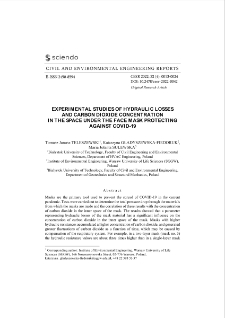Zielonogórska Biblioteka Cyfrowa udostępnia 65 391 obiektów cyfrowych
Obiekt
Tytuł: Experimental Studies of Hydraulic Losses and Carbon Dioxide Concentration in The Space Under The Face Mask Protecting Against Covid-19
Autor:
Teleszewski, Tomasz Janusz ; Gładyszewska-Fiedoruk, Katarzyna ; Sulewska, Maria Jolanta
Data wydania:
Typ zasobu:
Współtwórca:
Tytuł publikacji grupowej:
Abstract:
Masks are the primary tool used to prevent the spread of COVID-19 in the current pandemic. Tests were carried out to determine the total pressure drop through the materials from which the masks are made and the correlation of these results with the concentration of carbon dioxide in the inner space of the mask. ; The results showed that a parameter representing hydraulic losses of the mask material has a significant influence on the concentration of carbon dioxide in the inner space of the mask. Masks with higher hydraulic resistances accumulated a higher concentration of carbon dioxide, and generated greater fluctuations of carbon dioxide as a function of time, which may be caused by compensation of the respiratory system. For example, in a two-layer mask (mask no. 3) the hydraulic resistance values are about three times higher than in a single-layer mask (mask no. 1). ; The study also noticed that the inscriptions and prints placed on the masks increase the hydraulic resistance of the material from which the masks are made, which may also contribute to the accumulation of carbon dioxide in the space between the mask and the face. To reduce the accumulation of carbon dioxide within the inner space of the mask, the results of this work suggest searching for mask materials with the lowest possible hydraulic resistance.
Opis:
tytuł dodatkowy: Prace z Inżynierii Lądowej i Środowiska
Wydawca:
Zielona Góra: Oficyna Wydawnicza Uniwersytetu Zielonogórskiego
Format:
Identyfikator zasobu:
DOI:
Strony:
Źródło:
Civil and Environmental Engineering Reports (CEER), no 32, vol. 4
Jezyk:
Licencja CC BY-NC-ND 3.0:
Prawa do dysponowania publikacją:
Biblioteka Uniwersytetu Zielonogórskiego
Kolekcje, do których przypisany jest obiekt:
- Zielonogórska Biblioteka Cyfrowa > Repozytorium > Jednostki organizacyjne > Wydział Budownictwa, Architektury i Inżynierii Środowiska
- Zielonogórska Biblioteka Cyfrowa > Repozytorium > Typy utworów > Artykuły
- Zielonogórska Biblioteka Cyfrowa > Repozytorium > Czasopisma naukowe i serie wydawnicze UZ > Civil and Environmental Engineering Reports (CEER) > Civil and Environmental Engineering Reports (CEER) (2022)
Data ostatniej modyfikacji:
6 lip 2023
Data dodania obiektu:
31 mar 2023
Liczba wyświetleń treści obiektu:
188
Wszystkie dostępne wersje tego obiektu:
https://www.zbc.uz.zgora.pl/publication/80025
Wyświetl opis w formacie RDF:
Wyświetl opis w formacie OAI-PMH:
Obiekty Podobne
Lewicki, Zbigniew
Danielak, Wiesław Stankiewicz, Janina - red. nacz. Preston, Peter- red. jęz. Zmyślony, Roman - red. statyst. Skalik, Jan - red. Moczulska, Marta - red. Adamczyk, Janusz- red.
Śmietanka, Tomasz Kuczyński, Tadeusz - red.
Borysov, Roman Szaban, Dorota - red. Trzop, Beata - red.
Dalecka-Zaborowska, Magdalena Danielak, Wiesław - red. nauk. Niewiadomski, Przemysław - red. nauk. Sobotkiewicz, Dariusz - red. nauk.
Kleszczyński, Kamil Nyćkowiak, Justyna - red. Kołodziej, Tomasz - red. Jasny, Michał - red.
El-Douh, Ahmed Abdel-Rahim Lu, Song Feng Elkouny, Abdelatif A. Amein, A.S. Korbicz, Józef (1951- ) - red. Uciński, Dariusz - red.
Bedka, Aleksandra Gorzelana, Joanna - red. nauk. Seul, Anastazja - red. nauk.

